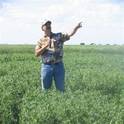
Presentation
Long-Term Tillage Frequency Effects on Dryland Soil Physical and Hydraulic Properties
15th International Soil Congress Organization Convergence
(2008)
Abstract
Soil tillage is considered one of most important practices in agricultural production due to its influence on physical, chemical, and biological properties of the soil environment. The effect of a long-term tillage [no-till (NT), spring till (ST), and fall and spring till (FST)] was investigated on soil penetration resistance (PR), bulk density (BD), gravimetric water content (GWC) and saturated hydraulic conductivity (Ks) under dryland conditions. Tillage effects on these physical properties were tested after 22 years on a Dooley sandy loam (fine-loamy, mixed Typic Argiborolls) derived from glacial till parent material. The statistical design used was a randomized complete block with four replications. Undisturbed soil cores were sampled at 0 to 5, 5 to 10, and 10 to 15 cm depths and were used to measure BD, GWC, and particle size distribution. Soil PR was measured by pushing a hand-held digital penetrometer into the soil at three locations across each plot. Statistical analyses indicated that soil PR was significantly greater in the NT (1.75 MPa) compared to both ST and FST treatments at P < 0.05. The PR generally increased with soil depth in all three treatments. Soil BD was not significantly affected by tillage. Averages BD for NT, ST, and FST were 1.59, 1.58, and 1.61 Mg m-3, respectively. The NT plots had greater GWC followed by ST and then followed by FST. The data on Ks at 15 to 20 cm depth were highly variable and tillage treatments had no significant effect on soil Ks. Long-term frequency of tillage reduced compaction in the soil surface (0 to 10 cm), but increased in the subsurface soil (>10 cm) due to the traffic intensity induced by tillage system. The results generally showed that tillage intensity effectively altered soil PR, and minimally affected soil BD and GWC, but moderately affected Ks during the past 22 years.
Keywords
- soil,
- Dooley sandy loam,
- penetration resistance,
- dryland
Disciplines
Publication Date
2008
Comments
Works produced by employees of the U.S. Government as part of their official duties are not copyrighted within the U.S. The content of this document is not copyrighted.
Citation Information
Andrew W. Lenssen, J. D. Jabro, U. M. Sainju, W. B. Stevens, et al.. "Long-Term Tillage Frequency Effects on Dryland Soil Physical and Hydraulic Properties" 15th International Soil Congress Organization Convergence (2008) Available at: http://works.bepress.com/andrew_lenssen/76/
